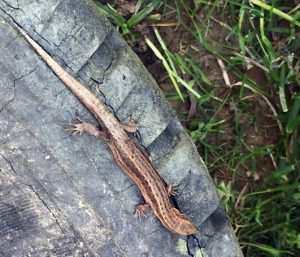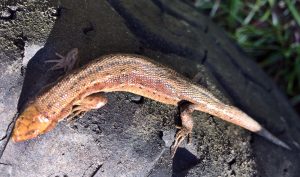Refuges for wildlife

Visiting a woodland recently I noticed the messiness of some piles of old tyres and how they didn't seem to fit in well with an ethos of conservation. The manager explained that the tyres are used by small mammals such as mice and voles and they are full of interesting wildlife. Challenged to find a lizard on a sunny day, I picked through the tyres and found several, one of which was obliging enough to be photographed. Tyres represent a habitat for small mammals and reptiles that gives protection from the weather but also from predators. Also water gathers in the bottom of some of them and the puddles are useful for these animals.
Tyres in woodland can be a great nuisance if large numbers have been dumped. They are expensive to dispose of, costing as much as £2 each to have taken away and companies will only take them if you have got them to the roadside and have a reasonable quantity. Most woodland owners will want to get them off-site and will have to pay to have them removed. One reason it's expensive is because landfill sites don't like them - they fill a lot of volume and are therefore wasteful of landfill space.  Recycling can use them as part of an asphalt mix for roadbuilding. Old tyres can even be burnt at high temperatures but they are still expensive for the landowner to get moved.
Recycling can use them as part of an asphalt mix for roadbuilding. Old tyres can even be burnt at high temperatures but they are still expensive for the landowner to get moved.
If you do decide to keep dumped tyres some of them can be used for marking edges to tracks or even for making swings and parts of assault courses. Some people have filled them with earth and used them for walls in eco houses or shelters.
Apart from old tyres, another way to attract lizards and snakes is to put down some corrugated sheet of steel in your woodland. In the sunshine these get remarkably warm and the metal sheets become a place that reptiles enjoy - both on top and underneath the corrugated. Adders like to make their homes underneath corrugated steel sheets.
Comments are closed for this post.
Discussion
Agree with most of what you say…..my only concern is that after use on our roads, tyres tend to be contaminated with ‘heavy metals’,which isn’t good for most wildlife.

Unlikely to be contaminated with very much for very long; they are more likely to be contaminated with brake dust from brake pads or salts and petrochemicals from the roads – but even a short journey in rain we help to remove it.
Anything the tyres pick up from the road will be worn away within a few 100’s of revolutions. (I mean tyres do wear away after all)
However, so called heavy metal are a constituent part of the material used in tyre manufacture, so are present in them rather than contaminating them. There has been concern over tyres used to make artificial reefs and the effect of the HM has been studied. (http://icesjms.oxfordjournals.org/content/59/supplement/S243.full.pdf). Also, it has been shown that pollutants can leach from tyres buried in soil, particularly if shredded (larger surface area).
So best advice – “use common sense”, a few tyres here and there in a corner provide a haven for wildlife, and the impact if any is small. A few hundred that might be different.
rich
24 May, 2016